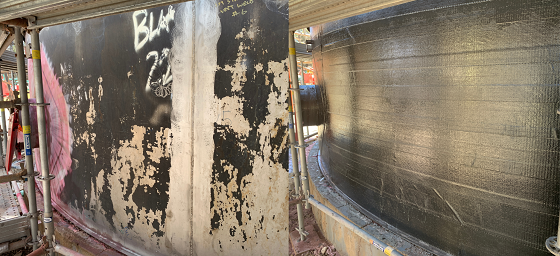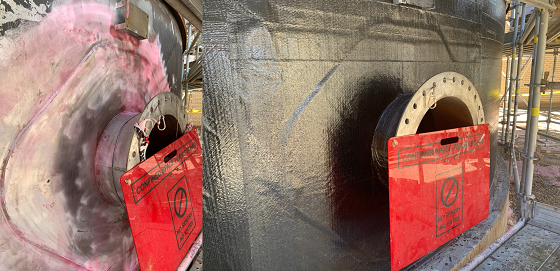At a major global blue-chip nickel mine in Australia, Rezitech — an authorized distributor and installer of Belzona’s industrial protective coatings and epoxy metal repair composite products — recently provided a full turnkey solution to combat corrosion under insulation (CUI) on an ammonium sulfate feed tank.
Within the space of 24 hours, the site’s 9.5-m (31.2 ft) diameter tank was repaired and protected against future corrosion with the industrial composite wrap system Belzona SuperWrap II. The tank is located approximately 2 meters (6.6 ft) from ground level.
Supporting a Net-Zero Transition
The Australian mine refines granulated nickel matte from its smelter into premium-grade nickel powder and briquettes, which contain 99.8 percent nickel. Nickel powder is further processed into nickel sulfate (NiSO₄) at an Australian refinery. According to the client, NiSO₄ is an essential ingredient in the lithium-ion batteries that drive electric vehicles (EVs).
“It could be argued that the increase in sales of EVs is one of the biggest climate wins of recent years,” said Chloe Hirst, a senior copywriter for Belzona based in Harrogate, United Kingdom. “According to the 2023 report from Climate Action Tracker, of the 42 sectors which need to achieve net zero-status by 2050, the only sector which is on track is the share of EVs in light-duty vehicle sales. Considering how road transport currently accounts for 11 percent of global greenhouse gas emissions, EVs play a vital role in reducing these emissions.”
As such, the polymeric technology required to repair and improve EV assets can play a vital role in supporting this transition. By repairing damaged assets instead of decommissioning and sending them to landfills, this significantly reduces the climate impact that could otherwise be incurred in this process.

Feed Tank Plagued by CUI, SCC
At the Australian mine, the customer’s stainless steel feed tank was suffering from CUI and chloride-induced stress corrosion cracking (SCC). The customer required a solution that would restore the substrate’s integrity while also protecting the asset against future corrosion damage.
In addition, since the tank operates at elevated temperatures of approximately 70 °C (158 °F) and processes a highly corrosive medium, the repair solution needed to be able to withstand these types of harsh conditions.
Having worked with Rezitech over the course of five years, the client had confidence in the range of metal epoxy repair composites and industrial repair coatings. As such, it reached out directly to seek out advice and a recommended system solution.
Following an inspection by Heath Westell, sales engineer at Rezitech, the SuperWrap II system was then specified.
“This composite wrap system is comprised of a fluid-grade resin system, a bespoke hybrid reinforcement sheet based on fiberglass and carbon fiber, as well as a release film to compact and consolidate the application,” Westell said.
“The system is specially formulated to restore the strength of holed, weakened, and corroded pipe and tank walls, making it the ideal solution for protecting the asset against CUI for the long-term,” he noted. “In addition, thanks to the cold-curing properties of the composite wrap system, this mitigates the need for hot work. This makes it a reliable alternative to welding.”
Application Procedures
The initial step in the application process was surface preparation. To achieve this, all traces of oil and grease contamination were removed using a suitable Rezitech degreaser.
Following this, all surfaces were grit-blasted to provide a cleanliness compliant with the NACE No. 2/Society for Protective Coatings (SSPC) Surface Preparation (SP) 10/Sa 2 ½ standard for “Near-White Metal Blast Cleaning.” This includes a minimum 75-micron (3 mil) rough angular profile.
Once the surface was prepared, a Belzona 9381 reinforcement sheet was measured and then wetted out with the resin system. The resin was then systematically applied to the areas to be repaired.
From there, the reinforcement sheets were applied to the tank in three layers, with a compression film added to the top of the application area. Next, the SuperWrap II composite wrap system was spread, rolled, and compressed to the tank’s surface. The system was then left to cure for approximately eight hours.

Bypassing Replacement Needs
By investing in the composite wrap solution, the customer was able to successfully bypass the need to replace the corroded asset, according to the distributor. Instead, it prolonged the asset’s lifespan for years to come, thereby allowing the client to achieve significant savings in both time and money.
“In addition, given the important role that EVs play in reducing global carbon emissions, it could be argued that polymeric technology also plays a fundamental role in supporting this transition by safeguarding the integrity of key industry assets,” Hirst concluded.
For more information, visit: Belzona, www.belzona.com; Rezitech, www.rezitech.com.au